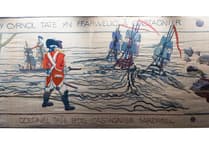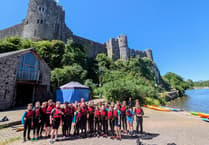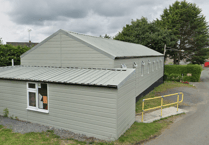This month I have chosen to write a “travelogue”, if I can be that grand, about a wonderful day out my husband and I enjoyed some years ago when we lived in Pembrokeshire.
Travelling by road was always enjoyable, locals knew the ‘timetable’ for the best times to do so, carefully avoiding the ‘milking hours’ twice a day and heavy rain (the ditches at the sides of the roads were shallow and full of pine cones, leaves, and hedge-cuttings, and therefore liable to flood in stormy weather).
If you have not yet discovered the exceptional beaches, great walks, first class seafood and friendly locals then I would recommend setting aside a few days to do your own exploring and if possible fit in a trip up the Cleddau. You may well then become smitten, especially by Pembrokeshire. If you are able, plan a “midweek weekend’’ then peruse a local road map and grab a welcome guide that would have been prepared with you in mind! And set off.
“
You may well then become smitten, especially by Pembrokeshire.
Sara John
A brief word of warning. Driving into Pembroke town one hot day I was surprised to see a number of stationary vehicles ahead of me. Jumping out of the car to see what the hold up was about I heard loud and cross sounding mooing. The cows were being moved, they did not want to move and did not see the point of it or understand what purpose it would serve.
One of the cows had a good idea, “follow me” she mooed to her chums and she turned sharp right to trundle down the line of, by now hot parked cars and their travellers. She swiftly selected a very full car of assorted ages who had (foolishly) opened all their windows. Mrs Cow, I did not know her first name and you might not appreciate that all newly born cows are christened by the farmer and blessed with a nice name by the daughter of the house when they are very small. Frequently the name will be a traditional Welsh name such as Gwenllian, Angharad or Morfydd. Mrs Cow managed to get her head in through one of the open windows. She did not enjoy a Welsh welcome but in fact was frightened off with loud panic stricken female screaming.
The moral to this tangent? If livestock are being dealt with, stay out of the way. If you meet cows in a field on your explorations give them a very wide berth. They can cause serious injury, after all you are invading their home space.
On a fine and sunny day in July some years ago, 30 Friends of the Pembrokeshire National Park set off on one of Mrs Potter’s Excellent Expeditions - as it would have been called in earlier times. It was a wonderful trip, we travelled in a flotilla of boats, sailing down the Haven under the bridge, rather than driving over it, then back up the Cleddau estuary to see the “other side” of the ancient settlements on its banks. It was truly an opportunity to explore the busy waterway that was once the main access into Haverfordwest.
“
30 Friends of the Pembrokeshire National Park set off on one of Mrs Potter’s Excellent Expeditions - as it would have been called in earlier times.
Sara John
Haverfordwest or Haver Fjord (meaning a corn inlet) was first used by a group of Viking Pirates who settled in the region in the 8th century. It lies at the highest navigable point on the Western Cleddau. Haverfordwest like so many busy quays on the waterway, such as the smaller settlements of Hook and Lawrenny, were victims when the bulk of the sea trade was killed off with the coming and, subsequent rapid expansion of the railways, in 1853.
Our journey began at Neyland, where the grand statue of Mr Brunel (by Rhondda sculptor Robert Thomas) stands as a tribute to his attempt to create an embarkation point to the USA. Our journey then continued with a detour, down the estuary, towards the open Irish Sea. Afterwards we turned around and then sailed up the Cleddau in the direction of Haverfordwest. Sliding silently past Lawrenny, LLangwm and Hook, so much gentler travelling on the water than on a tarred hard road. I began to wonder if the view from this “other” dimension could also be extended back in time, into the past.
In earlier times the estuary would have been packed with shipping carrying cargoes of oysters, coal, limestone, and, with ferries weaving their way across the estuary. There would have been people on pleasure boats like ourselves and important visitors arriving by boat at the large waterside estates.
We passed fairytale medieval Benton Castle, perched on its promontory on the steep cliffs of the western bank. Described in a letter to Edward LLwyd in 1693 as, “Benton Castle formerly said to be haunted, upon which account seldom visited, where they say the Devil would often appear in the shape of a black mastiff dog, and sometimes lie by the fire, but mostly in the vault or the cellar, to guard some hidden treasure there”.
A little further on we were reminded, by our Captain, that industry had come early to the Cleddau Estuary with coal mining around the Landshipping area offering employment to miners from the seventeenth century. Landshipping is one of the earliest areas which shipped out coal and culm in barges and small sailing vessels, output was said to have reached ten thousand tons a year by the early years of the nineteenth century. As one would expect, Landshipping Colliery was the biggest in the county in terms of manpower. It is claimed that the Garden Pit, as it was known, close to Landshipping Quay was sixty metres deep. Forty lives were lost there in a disaster in 1844, some authorities suggest it was the first great national coal disaster.
“
Landshipping Colliery was the biggest in the county in terms of manpower.
Sara John
In the past, vessels travelling downstream with their cargoes of coal and culm would pass the boats coming upstream bringing shop goods, limestone, fertiliser and timber to the area.
The river carried small black-tarred rowing boats, used for ‘compass’ fishing which can still be seen today. Previously, barges and brigs, ferries, small and large sloops, schooners and ketch boats all went about their business on this busy vital waterway.
On the eastern bank, a little further on and back in the present, the outline of Coed Canlas came into view. A property well established when Henry Tudor returned from France to lay his claim to the throne of England and the rallying place for his supporters from that part of Pembrokeshire. The property now being renovated – again – it boasts walls that are nine feet thick, and it was large enough in the seventeenth century to. attract taxation for “ten hearths”. The house was rebuilt on the old foundations in 1718.
Three miles south of Haverfordwest on the eastern bank of the estuary, the old ruins of the ancient mansion of Boulston could be seen, a considerable property that was three stories high and with thirteen hearths and extensive cellars. It passed to family members who were resident in Norfolk and was abandoned as a residence in 1715. Set further back on the high ground is Boulston Manor built in 1797 by Major Dudley Acland, and still a family home.
Christopher Webbe, Gent, staying at the Havens, St Brides from 1880 to 1881 wrote a series of letters to his friend Humphrey Holdfast of Great Yarmouth which were subsequently published. These are interesting for his curiosity, detailed comments and the fact that nothing had been noted in print of the parishes of Pembrokeshire since Fenton’s book circa 1810.
Especially interesting are his notes on what he calls ‘Langum Women’.
“
Their husbands are kept under strict petticoat government, and you would hear a man described familiarly as ‘Jenny Palmer’s man’.
Christopher Webbe
He writes, “Fisherwomen, wearing short petticoats and jackets sometimes, pea-jackets, or “my man’s jacket”, as they would inform you if you asked them, a style of dress which leaves them free and unencumbered for travelling, as they call ‘walking’, bearing on their backs panniers frequently full of fish for sale.
He goes on, “burdens of fish and oysters going from door to door. Their husbands are kept under strict petticoat government, and you would hear a man described familiarly as ‘Jenny Palmer’s man’. It has sometimes happened that a man being asked his name, would, without any idea of fun, reply, - “Jenny Morgans by my own name but Jenny Thomas by my wife”. Their normal term of endearment is, “My honey”. A contemporary painting of one of these “Langum Women” is on permanent display in Tenby Museum. Webbe’s writing brings them back to life.
Following his description of the estuary that was our playground, just for a day, Webbe ends with these words, “Of this river a long account ought to be written, but I feel I lack the powers of description to qualify me for the task: at all events at present, we must let it go by”.
The group certainly enjoyed the trip in the (then) present day, and for some of us, also back in time.
I cannot recommend these little-known parts of West Wales more highly as inner (or landward) Pembrokeshire is often ignored by visitors in favour of the wonderful coastline. The air is clear and fresh, history abounds, there are lots of ancient buildings, ruins, and castles to see and glorious views of undulating countryside in myriad shades of green.
“
Inner Pembrokeshire is often ignored by visitors in favour of the wonderful coastline.
Sara John
If this article has whetted your appetite then make enquiries with local tourism outlets regarding the availability of trips on the Cleddau estuary.
Send your articles to [email protected].





Comments
This article has no comments yet. Be the first to leave a comment.